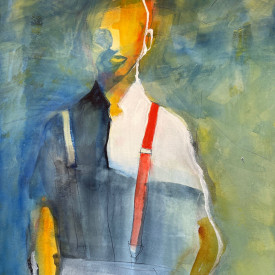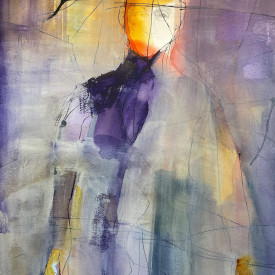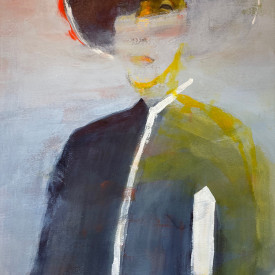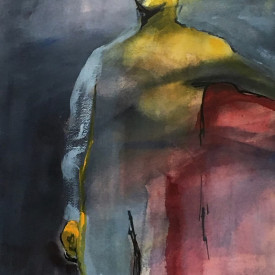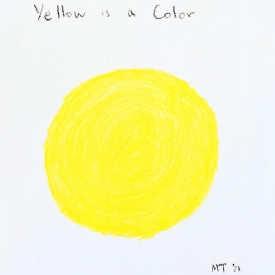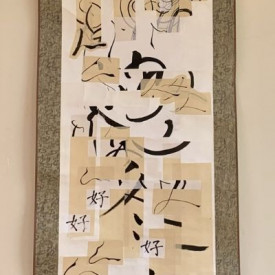Becoming (in)Visible: Countering Asian Hate
“I am invisible, understand, simply because people refuse to see me. Like the bodiless heads you see sometimes in circus sideshows, it is as though I have been surrounded by mirrors of hard, distorting glass. When they approach me they see only my surroundings, themselves or figments of their imagination, indeed, everything and anything except me.”
― Ralph Ellison, Invisible Man
Becoming (in)Visible, the current Cherry Center exhibition, shows us the Brave New World of what bias, hate and xenophobia look like in a world right in front of us. Hate crimes against Asian Americans and Pacific Islanders have increased nearly 170% in the first quarter of 2021, compared to the same time period in 2020, with more than 3,500 hate incidents reported over the past year.
The paintings and photographs in this exhibit explore these deeply troubling statistics through an array of themes, mediums and settings—with the shrouded notion of Asian Americans as perpetual foreigners a common denominator. The characterization of Asians in terms of otherness has often been stamped by exclusion, or, as Ralph Ellison writes, to only see ‘themselves or figments of their imagination.”
The artists here show us many worlds—the newly unseen, unknown, unacknowledged and invisible class. The images are at once introspective and direct, reflecting both the individual and systemic aspects of racism—the intimate aspects of bias rendered by the artists. Becoming (in)Visible depicts the human face of racism and the impulse towards hope.
The artwork in this exhibit are sometimes composed of seeming mini-stories, small dramas that give human expression to the vexing themes of race. This crowded human landscape—filled with uncertainty, pathos and dread — is now home for many Asians, and the current exhibit is a kind of spiritual guide to their– and our–complicated fates.
There are numerous ways to view the work in this exhibit. The artwork requests our consideration as social commentary, as themes unto themselves, for luminosity and composition, or for the sheer painful human drama.
One of the tasks of art is to disclose and shape our sense of the world. It is not to present ideals, but to present the emotional incisions related to social issues at our front doors. Becoming Visible bears witness to these anxieties — and discloses our own.
Robert Reese, the Carl Cherry Center for the Arts
Violence against minorities is never far below the surface of American life. As hate crimes move to the foreground once again, the exhibition Becoming (in)Visible; Countering Asian Hate assumes even greater significance. When Robert Reese asked me to help mount an exhibition which supports the individuals and communities affected by Asian hate crimes I was pleased to do so. For the past three years, I have been working on exhibitions concerned with Sansei artists looking back at the history of Japanese Americans and the American concentration camps during WWII. This provides the backdrop for my involvement with this show.
Gail Enns, Exhibit Co-curator
May 31, 2021
Becoming (In) Visible has been made possible through donations and grants
from the following individuals and organizations:
Mark Orrisch and Jana Clark
Monterey Bay Zen Center
Arts Council for Monterey County
Community Foundation for Monterey County
The Carl Cherry Center for the Arts gratefully acknowledge their support and contributions.

February 8, 1942 - 2016
Jerry Takigawa
Photography
24.5” x 18.75” x 1.25”
READ ARTIST STATEMENT

Jerry Takigawa
Photography
18.75 in. x 24.5 in. x 1.25 in.
READ ARTIST STATEMENT

Jerry Takigawa
Photography
18.75 in. x 24.5 in. x 1.25 in.
READ ARTIST STATEMENT

Jerry Takigawa
Photography
18.75 in. x 24.5 in. x 1.25 in.
READ ARTIST STATEMENT

Jerry Takigawa
Photography
18.75 in. x 24.5 in. x 1.25 in.
READ ARTIST STATEMENT

Belle Yang
Gouache
23 in. x 29" (framed)
READ ARTIST STATEMENT

Belle Yang
Gouache
16 in. x 19.75 in. (framed)
READ ARTIST STATEMENT

Joe Aki Ouye
Mixed Water Media
20.5 in. x 14.5 in.
READ ARTIST STATEMENT

Karen Nagano
Mixed Media
29.5 in. x 41.5"
READ ARTIST STATEMENT

Karen Nagano
Mixed Media
29.5 in. x 41.5"
READ ARTIST STATEMENT

in Monterey Bay Region"
Lucien Kubo
Mixed Media
16 in. x 16 in. x 1.5 in.

in Monterey Bay Region"
Lucien Kubo
Mixed Media
16 in. x 16 in. x 1.5 in.
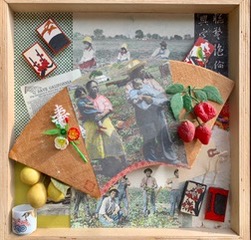
in Monterey Bay Region"
Lucien Kubo
Mixed Media
16 in. x 16 in. x 1.5 in.
!["Closing Out Evacuation Sale" 2019<br/>Lisa Solomon<br/>Watercolor on paper with cut outs<br/>overlaid on hand screen printed<br/> Sashiko Seigaiha [wave] patterned paper<br/>8 in. x 10 in.](https://carlcherrycenter.org/wp/wp-content/uploads/cache/2021/05/photos_ClosingOutEvacuationSale/894334671.jpeg)
Lisa Solomon
Watercolor on paper with cut outs
overlaid on hand screen printed
Sashiko Seigaiha [wave] patterned paper
8 in. x 10 in.
READ ARTIST STATEMENT
!["Japs Keep Out You Rats" 2019<br/>Lisa Solomon<br/>Watercolor on paper with cut outs<br/>overlaid on hand screen printed<br/> Sashiko Seigaiha [wave] patterned paper<br/>5 in. x 7 in.](https://carlcherrycenter.org/wp/wp-content/uploads/cache/2021/05/photos_JapsKeepOutYouRats/1370026577.jpeg)
Lisa Solomon
Watercolor on paper with cut outs
overlaid on hand screen printed
Sashiko Seigaiha [wave] patterned paper
5 in. x 7 in.
READ ARTIST STATEMENT
!["Japs Keep Moving This is<br/>a White Man's Neighborhood" 2019<br/>Lisa Solomon<br/>Watercolor on paper with cut outs<br/>overlaid on hand screen printed<br/> Sashiko Seigaiha [wave] patterned paper<br/>8 in. x 10 in.](https://carlcherrycenter.org/wp/wp-content/uploads/cache/2021/05/InvisibleJapsKeepMovingv1/3220959012.jpg)
a White Man's Neighborhood" 2019
Lisa Solomon
Watercolor on paper with cut outs
overlaid on hand screen printed
Sashiko Seigaiha [wave] patterned paper
8 in. x 10 in.
READ ARTIST STATEMENT
!["Evacuation Sale" 2019<br/>Lisa Solomon<br/>Watercolor on paper with cut outs<br/>overlaid on hand screen printed<br/> Sashiko Seigaiha [wave] patterned paper<br/>7 in. x 5 in.](https://carlcherrycenter.org/wp/wp-content/uploads/cache/2021/05/photos_evacuationsale/3067435899.jpeg)
Lisa Solomon
Watercolor on paper with cut outs
overlaid on hand screen printed
Sashiko Seigaiha [wave] patterned paper
7 in. x 5 in.
READ ARTIST STATEMENT
!["Down With Japs the Rats" 2019<br/>Lisa Solomon<br/>Watercolor on paper with cut outs<br/>overlaid on hand screen printed<br/> Sashiko Seigaiha [wave] patterned paper<br/>6 in. x 4 in.](https://carlcherrycenter.org/wp/wp-content/uploads/cache/2021/05/photos_DownwiththeJapstheRats/788064005.jpeg)
Lisa Solomon
Watercolor on paper with cut outs
overlaid on hand screen printed
Sashiko Seigaiha [wave] patterned paper
6 in. x 4 in.
READ ARTIST STATEMENT

Lisa Solomon
Watercolor and embroidery on
paper mounted to board
10 in. x 10 in.
READ ARTIST STATEMENT

Tule Lake" 2017
Lisa Solomon
watercolor, graphite, color pencils,
embroidery on various papers, pins,
painted pagoda/toro, shelf on wood panel
10 in. x 10 in.
READ ARTIST STATEMENT

of Japanese Ancestry" 2019
Lisa Solomon
Sashiko embroidery on fabric
64 in. x 41 in.
READ ARTIST STATEMENT

of Monterey Bay - 2016"
Jerry Takigawa
Photography
18.75 in. x 24.5 in. x 1.25 in.
READ ARTIST STATEMENT

